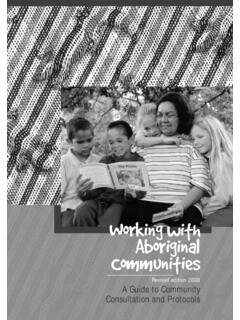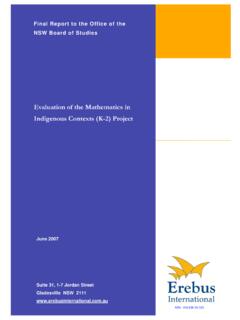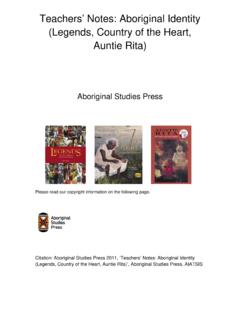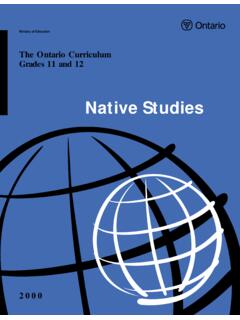Transcription of Otitis Media - Aboriginal Educational Contexts
1 Otitis Media and Aboriginal Children A HANDBOOK FOR. TEACHERS AND. COM MUNITIES. Design Rationale On the left is an ear represented in stencil form. The circles lead into the ear. Lines to the circles show that hearing loss can be partial, shown by dotted ends. Wavy lines leading into the ear indicate the different influences on hearing. At the bottom is the family who keep the health of the community through their children. In the middle are message sticks representing the importance of culturally relevant education which provides motivation for learning. The concentric circles at the top represent the different mainstream institutions.
2 Health, Housing, Education, Law, Department of Community Services, etc that need to be involved in the wellbeing of all Aboriginal children. Neil Thorne Kamilaroi This project is being funded by the Aboriginal Education Strategic Initiatives Program under the National Aboriginal and Torres Strait Islander Education Policy through the Department of Employment, Education and Training. Board of Studies NSW 1994. Published by Board of Studies NSW. PO Box 460. NORTH SYDNEY NSW 2059. Tel: (02) 925 8111. ISBN 0 7310 3325 6. October 1994. 94078. Contents Page Introduction 1. Some Facts about Otitis Media 2. Section 1. The Hearing Process 4.
3 What is Otitis Media ? 5. Types of Hearing Loss and their Causes 6. Educational Implications of Otitis Media 8. Otitis Media and Aboriginal Children 11. Section 2. Otitis Media Whose Problem Is It? 18. Strategies to Identify Hearing Loss 18. Diagnostic Checklists 22. Classroom Teachers' Responsibilities 26. Teaching Strategies 27. Section 3. Otitis Media and Cultural Issues 30. Otitis Media and Aboriginal English 32. Continuity and Transition for Aboriginal Students 34. Section 4. Consultative Process 38. Networking 42. Strategies and Activities for Teachers 43. Glossary 54. Bibliography 58. Acknowledgments The Board of Studies would like to acknowledge the principal authors of this document, Ms Juanita Sherwood and Ms Kim McConville.
4 The Board of Studies also wishes to acknowledge the NSW Aboriginal Education Consultative Group Inc for reading, consulting and endorsing the document and the Koori Centre, University of Sydney for their resource material on community consultation. The Board of Studies acknowledges Mort Johnson, Damien Howard, Anne Lowell and Clare Loades for their support in the development of this document and their ongoing work in the area of Otitis Media . Introduction For many Aboriginal children, Otitis Media is a chronic condition with long-term health and Educational effects. The persistence of the disease and its long-term effects is due partly to a lack of awareness of the disease among parents, teachers and health workers, and partly to the lack of agreement about who is responsible for treating the disease and its effects.
5 This book seeks to help overcome these problems by explaining what Otitis Media is and by showing teachers and other school staff what role they can play in the shared responsibility for students who suffer from it. The book provides: a plain English explanation of the disease and its Educational effects;. a discussion of the shared responsibilities for treating the disease;. strategies to assist teachers to identify students who suffer from Otitis Media ;. teaching strategies to ensure that students who suffer from the disease still succeed at school;. a definition of the support network available to teachers, including the Aboriginal Education Assistant (AEA), the Aboriginal Education Resource Teacher (AERT) and the Itinerant Support Teacher Hearing Impairment (ISTH).
6 Advice for involving parents and community members in the children's education, ie techniques to be utilised in the home as well as in the classroom. This book may be used in conjunction with the video Can't Hear Can't Learn: Promoting an Understanding of Otitis Media in Aboriginal Children produced by the NSW Department of School Education. Otitis Media and Aboriginal Children 1. Some Facts About Otitis Media Otitis Media (OM) is a common childhood disease 75% of all children have had one episode of OM by the age of five and for some it may continue throughout school life. A child with Otitis Media may have fluctuating hearing loss.
7 This means that hearing loss will vary, depending on the stage of the disease. Otitis Media may cause rupturing of the eardrum. This is known as a perforated eardrum. Some children suffer so many infections that the perforation never heals. Others develop scarring on the eardrum from multiple infections. These children have permanent conductive hearing loss (CHL). Conductive hearing loss during early childhood may cause delays in oral language development. While Otitis Media occurs in all cultural groups, it is at least ten times more common among Aboriginal children than among non- Aboriginal children. As many as eight out of ten Aboriginal children could have a middle-ear infection and associated hearing loss at some time during the school year.
8 Hearing loss can compound the disadvantage experienced by Aboriginal children for whom standard English is a second dialect, particularly in schools which do not take account of the implications of this. If children can't hear properly, they can't learn properly. 2 Otitis Media and Aboriginal Children Section 1. The Hearing Process The hearing process begins with sound waves entering the outer ear, travelling along the ear canal, hitting the eardrum and causing it to vibrate. The vibrating drum causes the three small bones (malleus, incus and stapes, known as the ossicles) in the middle ear to vibrate. The last bone, the stapes, hits the oval window creating waves in the fluid in the cochlea (inner ear).
9 The waves move hair cells which in turn stimulate the auditory nerve. The auditory nerve carries the information to the brain. Semicircular canals Bone Malleus Oval window Eardrum Nerve to brain es nd wav Sou Cochlea Incus Stapes Outer Middle ear ear Eustachian tube 4 Otitis Media and Aboriginal Children Section 1. What is Otitis Media ? Otitis Media ' is the medical term for middle-ear disease. It comes from the Greek word Otitis which means inflammation of the ear and the Latin word Media which means middle. Thus, Otitis Media simply means inflammation or infection of the middle ear. This disease is a common childhood ailment which may affect many children before the age of five years.
10 Seventy-five per cent of all children will have at least one episode of OM by the age of five. How is Otitis Media usually caused? Otitis Media can be caused by a cold, flu, allergy (asthma/hayfever), or chest infection. The inflammation from all of these illnesses causes the Eustachian tube (the tube that connects the ear to the back of the throat) to swell up. This stops the normal ventilation of the middle ear. The middle ear space then becomes full of a very sticky fluid which restricts movement of the ossicles. This reduces the conduction of sound waves through the middle ear to the inner ear and so reduces the messages to the brain.







